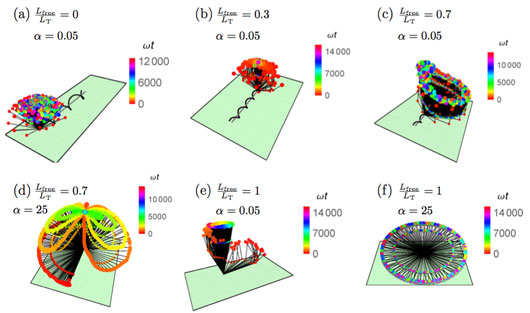Bacterial biofilms are integrated communities of cells that adhere to surfaces and are fundamental to the ecology and biology of bacteria. Surface detachment and irreversible attachment of cells are two opposing fundamental processes in the development of these biofilm communities. It is known for example that Pseudomonas use their flagella to detach from a surface, but the details are sketchy. By combining the expertise of theoretical physicists, bioengineers, and microbiologists in a HFSP multidisciplinary collaboration, we are able to show how individual cells perform the intricate flagellum-dependent actions that lead up to detachment.
Our high speed microscopy data show that bacteria attached to a surface go through a series of spinning movements via the flagellum motor before detaching from a surface. We formulated a hydrodynamic model, which calculates the forces and torques between the bacteria, the surface and the surrounding fluid. Different quantities in the model are varied to see how they affect the spinning behavior. Surprisingly, we find that different species of bacteria go through different variations of pirouettes due to the different hydrodynamics that result from different head shapes: Pseudomonas aeruginosa has a straight head, Shewanella oneidensis has a slightly curved head and Vibrio cholera has a very curved head. These shapes are shown in Figure 1.

Figure 1: The different bacterial species we study have different body shapes
When bacteria rotate faster, intuition suggests that the flagellar motor must exert a higher torque. However, our model shows that the orientation of a bacterium also has a significant effect on the speed due to the resistance from surrounding fluid. Moreover, the attachment geometry of the bacterium also matters. Part of the flagellum is stuck to the surface and the remainder is free. The ease with which the free part can bend away from the fixed part increases with its length, so flagellum length can impact resistance from the fluid: more movement of the flagellum increases resistance, but if the head is further from the surface there is less resistance. Varying these structural parameters gives the full range of spinning that we observed experimentally. Figure 2 shows some representative examples of various motions that our model produces. Finally, we observed that the different bacterial species detach from the surface at different angles using microscopy. The theoretical model successfully predicts the different detachment angles as a result of the different head shapes.

Figure 2: Samples of the different spinning behaviors we obtain from the model. The colored spots follow the two ends of the body segment, with the color representing time. The parameter α measures the ratio between the hook stiffness and the motor torque. The other relevant parameter is the fraction of the flagellum that is free.
Reference
Species-dependent hydrodynamics of flagellum-tethered bacteria in early biofilm development. R. R. Bennett, C. K. Lee, J. De Anda, K. H. Nealson, F. H. Yildiz, G. O. O’Toole, G. C. L. Wong, R. Golestanian, Journal of the Royal Society Interface, 13, 20150966 (2016). doi: 10.1098/rsif.2015.0966. PMID: 26864892.


































